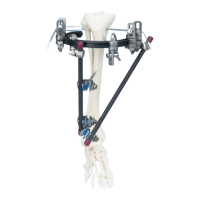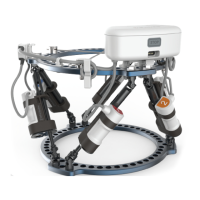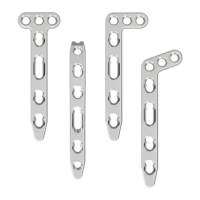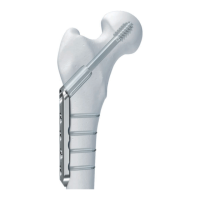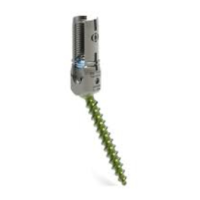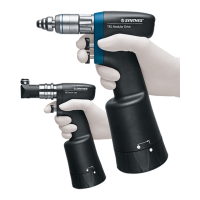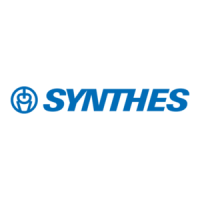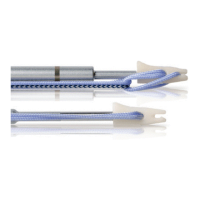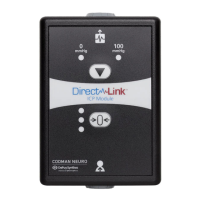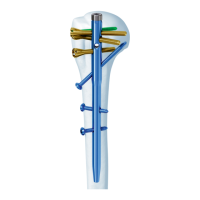
Do you have a question about the Synthes MultiLoc Proximal Humeral Nail and is the answer not in the manual?
| Brand | Synthes |
|---|---|
| Model | MultiLoc Proximal Humeral Nail |
| Category | Medical Equipment |
| Language | English |
Details the features of MultiLoc screws, including blunt tips, countersunk heads, and suture holes for rotator cuff attachment.
Explains the optional ASLS for improved fixation in poor bone quality.
Details lateral (A, B, D) and anterior (C) screws for proximal stability and fixation.
Describes ascending screw for calcar support and distal screws for reduced toggling.
Outlines the four fundamental AO principles: Anatomic Reduction, Stable Fixation, Blood Supply Preservation, and Early Mobilization.
Lists indications for the MultiLoc Proximal Humeral Nail: 2-part, 3-part, and 4-part fractures.
Presents a case of a 78-year-old woman with a 2-part surgical neck fracture treated with an 8.0 mm nail.
Describes positioning patients in beach chair or supine positions for optimal C-arm visualization.
Details the anterolateral incision, deltoid muscle split, and caution regarding axillary nerve protection.
Identifies the ideal entry point on the humeral head, considering the medullary canal alignment and acromion access.
Details inserting the guide rod and making a longitudinal incision through the supraspinatus tendon.
Explains using hollow drill bits or a cannulated awl to open the medullary canal, with specific instructions.
Guides on assembling the insertion handle, connecting screw, and combination wrench for nail insertion.
Details advancing the nail into the medullary canal, monitoring passage, and verifying position to avoid impingement.
Instructions for attaching the lateral aiming arm to the insertion handle for screw placement.
Describes assembling the anterior aiming arm for anterior or ascending screw placement.
Determines nail insertion depth, ensuring the proximal end is below the cartilage for stability and to avoid impingement.
Guides on positioning the nail for the ascending screw, aligning the aiming arm with the screw hole.
Guides on drilling and measuring screw length using a drill bit or depth probe, avoiding articular surface penetration.
Explains overdrilling the lateral cortex with a conical drill bit in hard bone to countersink the screw.
Details inserting the MultiLoc screw using the screwdriver, ensuring proper countersinking and orientation for stability.
Guides on attaching a centering sleeve for 3.5 mm locking screws when used with MultiLoc screws.
Details attaching centering sleeves and drill sleeves for 3.5 mm locking screw insertion.
Guides on drilling and measuring screw length for 3.5 mm locking screws using drill bits or depth probes.
Details inserting the 3.5 mm locking screw using a torque limiting attachment for proper seating.
Guides on inserting additional 3.5 mm locking screws and reassembling the lateral aiming arm.
Details inserting the trocar assembly through the aiming arm for distal locking screw insertion.
Guides on drilling through both cortices and measuring screw length for distal locking screws.
Provides warnings about protecting the axillary nerve and drilling for the ascending screw.
Explains using a depth gauge for screw length determination in distal locking.
Details inserting the 4.0 mm locking screw using the StarDrive screwdriver.
Guides on determining the correct end cap length using an end cap ruler to prevent bony ingrowth.
Describes an alternative method for estimating extension length using an aiming arm and K-wire.
Details securely tightening the end cap using the StarDrive screwdriver, avoiding impingement.
Explains optional suture placement for improved stability, attaching them to screw holes.
Guides on removing the end cap using the StarDrive screwdriver and threading the extraction screw.
Details removing all 3.5 mm locking screws using the screwdriver shaft and handle.
Guides on removing MultiLoc screws and all 4.0 mm locking screws using appropriate drivers.
Describes removing the nail, ensuring all screws are removed, and using gentle hammer blows if needed.
Details titanium nails, material, diameters, color, length, and cross section.
Details 4.5 mm screws, material, drill size, color, dimensions, and features.
Details 3.5 mm screws, material, drill size, color, dimensions, and features.
Details 4.0 mm screws, material, drill size, color, dimensions, and features.
Details end caps, material, color, and extension options.
Lists instruments including cannulated awls, various drill bits, protection sleeves, and drill sleeves.
Lists instruments like trocars, handles, insertion handles, and aiming arms.
Lists extraction shafts, screwdrivers, depth gauges, and conical drill bits.
Lists centering sleeves, StarDrive screwdrivers, protection sleeves, and combination wrenches.
Lists universal chucks, torque limiting attachments, and combined hammers.
Lists Kirschner wires, drill bits, screwdriver shafts, and screw forceps.
Lists sterile versions of drill bits and guide rods for specific procedures.
Lists sterile aiming arm knobs and drill bits for specialized applications.
Lists all instruments included in the MultiLoc Proximal Humeral Nail Instrument Set (01.019.004).
Lists the implants included in the MultiLoc Proximal Humeral Nail Implant Set (01.019.005).
Details available MultiLoc nails, locking screws, and end caps with their part numbers.
Lists various lengths of 3.5mm and 4.5mm locking screws and end cap extensions.
